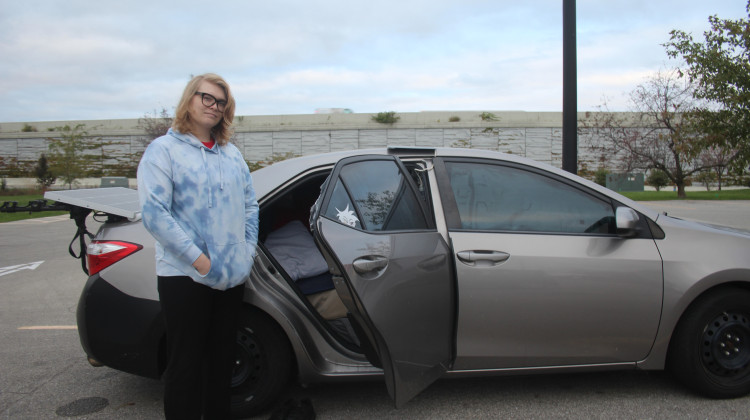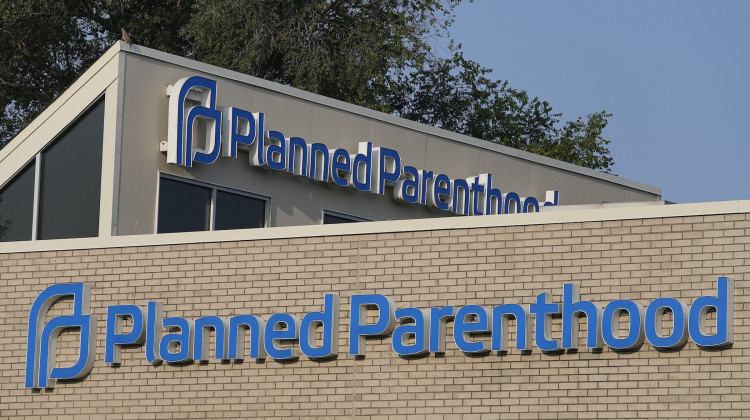
Ryan Warner stands in front of his car where he lives. He’s says finding a place to park for the night is a regular source of stress
Ben Thorp / WFYIRyan Warner’s car is packed tight and includes everything from a fire extinguisher to mini solar panels hooked to the roof, which help run fans to keep him cool.
Warner has been living out of his car for the past four months and says those fans have been essential to keeping him cool over a summer that frequently hit 90 degrees.
“Being stuck in a box like this, I know you could walk around and whatnot, but the weather is just absolutely brutal,” he said.
Warner works two jobs in fast food but is still paying off the lease from his old apartment before he can look for a new place to live. In the meantime, he has been staying in parking lots and the driveways of people who will let him crash. But that’s not always easy.
“Having to think about, should I park on this side of the road, but that's kind of dangerous, or should I park over there? Well, last time I got, you know, a ticket from a cop,” he said.
Between 2022 and 2023, homelessness increased by 12 percent across the country according to the U.S. Department of Housing and Urban Development. That rise has left many communities scrambling to address strains on local shelter systems and a lack of affordable housing.
Indianapolis has faced similar strains. Since 2019, Indianapolis has seen increases both in its overall homeless population and its unsheltered population, which can mean sleeping outside or in their car.
City officials and some advocates have disagreed on how best to use city funding to reduce homelessness, but generally agree that more resources are needed.
The clear need pushed Elizabeth Friedland to start Safe Park Indy in early October. It’s a parking lot on the North East side of the city that lets people park overnight.
“So, people can park in this lot [and] know that they're authorized to be here, not have to sleep with one eye open,” Friedland said. “They can also access some social services and amenities as well, such as indoor restroom facilities, a kitchen, Wi-Fi and a place to charge their devices, to try to make this tough time in their life a little bit easier.”
When the Safe Park Indy opened in October, Friedland said it had a waitlist of roughly 50 people. As of mid-October that number grew to 268.
According to Friedland, there are over 40 safe parking lots across the country, but most of those are clustered around the West Coast, with limited options in the Midwest. On the West Coast, safe parks have been a response to a growing housing affordability crisis.
Looking for solutions
Safe parking programs aren’t new, but they have faced a number of hurdles across the country. In some communities, they’ve seen pushback from locals afraid that parking lots might make their communities a destination for homeless people.
Other programs have struggled with long term funding, in part because the Department of Housing and Urban Development funding can only go to physical shelters.
But part of the allure of the safe parking lot approach is how relatively affordable they can be. All told, Friedland said she’s spent about $4,500 operating the parking lot for the first month. That includes all of the food and toiletries as well as a part time employee managing the facility.
For now, that funding has come through donations but Friedland hopes to also be able to bring in grants once the Safe Park is registered as a not for profit.
“We’re really hopeful that once we get our 501(c)(3) [status], we can apply for and get some grant money, so we can get more predictable funding and allow us to expand,” she said.
Since its launch, Friedland said she’s already been approached by other cities in Indiana hoping to replicate what she’s doing in Indianapolis. Within the city there are already plans to expand the number of parking lots and locations.
Those locations are needed because not everyone has been able to utilize the service, either because of the long wait list or because of difficulty getting to the lot.
Ryan Warner, for example, was on the waitlist but ultimately came off when he realized how far the address was from his two jobs. He worried about the cost of gas to and from work.
Safe Park Indy finds its footing
Safe Park Indy’s parking lot is next to a Church, which is letting Safe Park use a few rooms. There, Friedland showed off a rack packed with different kinds of food and boxes full of toiletries.
“The weather is getting cold. We’ve got hats, gloves, mittens, those kinds of things too,” she said as she gestured to a row of boxes along the wall.
The parking lot will let just ten people stay for up to two months. The hope is that this would offer them time to get on their feet and make space for the next person on the waitlist.
During his first night at Safe Park Indy, Tyler Pittman sat at a table and made small talk with other guests. He said he’s glad he was able to get into the parking lot.
“There is a level of organization and put togetherness that really impresses me,” he said.
Pittman, who has a college degree, has been living in his car for three months. He has struggled with substance abuse and said he is trying to focus on finding a job.
Most nights, Pittman said he has worried about finding a place to go to the bathroom.
“I can't, you know, urinate in my car, because if a cop were to come by, that's, you know, public whatever and then I'm in legal trouble,” he said. “They are bodily functions. You have to do it.”
During his time living in his car, Pittman said he’s realized just how bad the homelessness situation is in Indianapolis.
“It's working people. It's people educated, people with master's degrees, teachers, nurses,” he said. “This is a problem, and it's affecting areas of society that you don't typically associate with homelessness.”
While safe parking is still in its infancy in Indianapolis, it joins a long list of solutions and services vying for funding to be able to help more people.
“Everybody has their own needs and the same solution doesn’t work for everybody,” said Leslie Kelly, the director of programs for Horizon House, one of the city’s largest shelters.
She said while not everyone experiencing homelessness has access to a car, it’s just one more tool the city can use to help people without places to turn.
“We need family shelter[s] but that doesn’t mean we don’t need a viable opportunity for people living in their car to have a safe place to park,” Kelly said.
Friedland hopes to open a new safe park location by the end of the year.
You can join the waitlist for Safe Park Indy and find out more about services on their website.
Contact Health Reporter Benjamin Thorp at bthorp@wfyi.org
Side Effects Public Media is a health reporting collaboration based at WFYI in Indianapolis. We partner with NPR stations across the Midwest and surrounding areas — including KBIA and KCUR in Missouri, Iowa Public Radio, Ideastream in Ohio and WFPL in Kentucky.
 DONATE
DONATE






 Support WFYI. We can't do it without you.
Support WFYI. We can't do it without you.